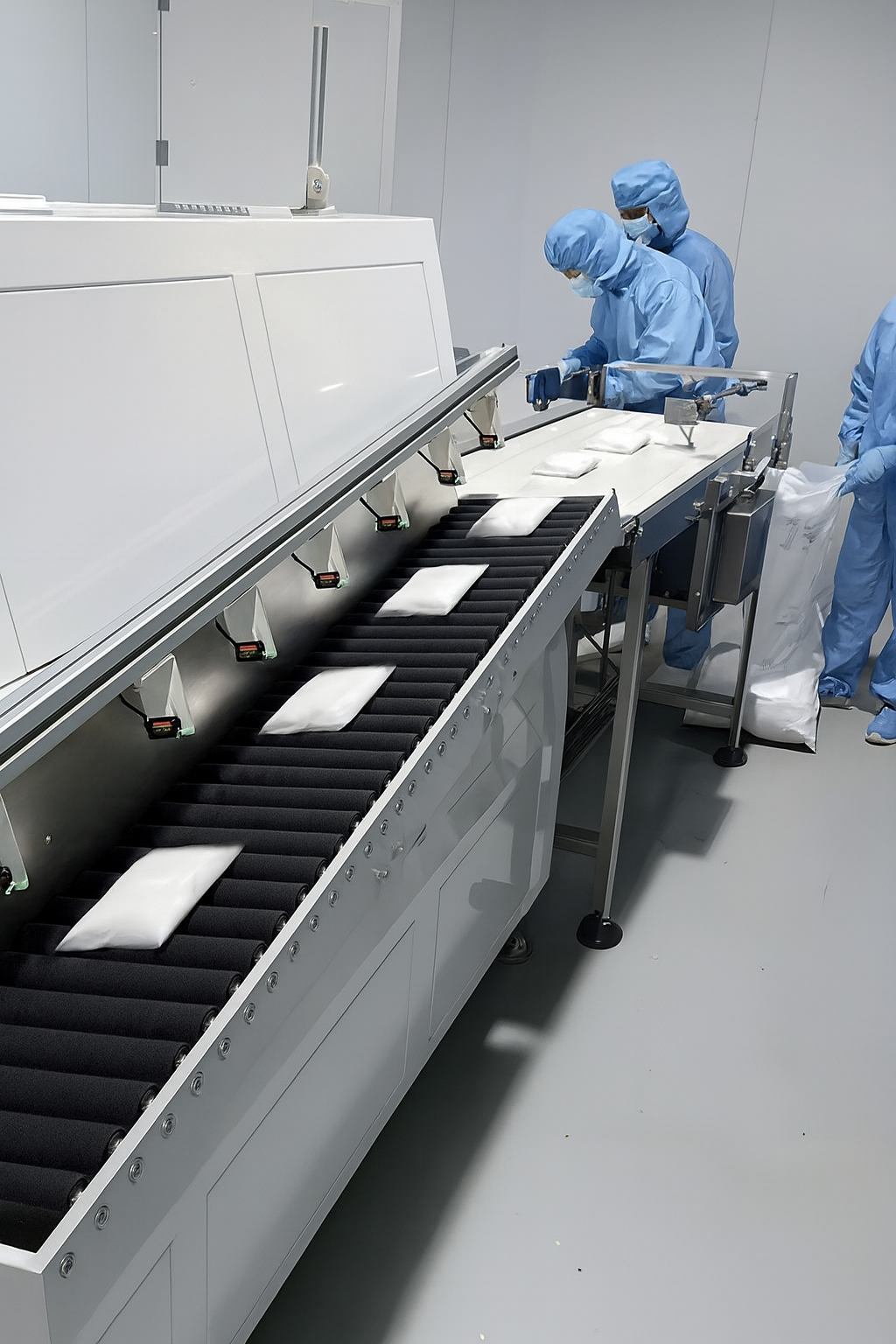In today’s fast-paced food industry, consumer awareness of food safety is at an all-time high. Every step from production to delivery must be optimized for hygiene, consistency, and compliance. As the final stage before distribution, packaging plays a crucial role in protecting food from contamination. Among the latest advancements in packaging automation, the sachet sorting machine stands out as a game-changing innovation.
This advanced equipment surpasses basic sorting. It automatically arranges sachets from a disordered state into precise alignment for downstream packaging processes such as boxing or case packing. By combining precision engineering, machine vision technology, and hygienic design, these machines redefine how food manufacturers ensure safety and efficiency.
How a Sachet Sorting Machine Works
Core Operating Mechanism
A sachet sorting machine uses multi-stage feeding and alignment systems to handle products with speed and accuracy. Sachets are loaded into a bulk hopper, where conveyor belts gently move them toward sorting units. Adjustable-speed rollers or belts position each sachet with the correct spacing and orientation.
High-sensitivity photoelectric sensors monitor the flow in real time. A PLC (Programmable Logic Controller) processes the data, adjusting servo-driven motors for precise, synchronized movement. This ensures that sachets are perfectly aligned before reaching the next stage of the packaging line.
Smart Automation Technology
Modern automatic sachet sorting machines incorporate multi-servo drive systems, giving independent control over each motion axis. Operators can adjust parameters for sachet size, weight, and shape, minimizing damage and ensuring optimal flow.
Advanced features include:
- Real-time monitoring dashboards
- Remote maintenance via IoT connectivity
- Predictive maintenance alerts to prevent downtime

Food Safety Advantages of Sachet Sorting Machines
Hygienic Construction
All contact surfaces are made from 304-grade stainless steel, ensuring resistance to corrosion, easy cleaning, and prevention of harmful leaching. Transparent polycarbonate covers shield the sorting process from dust and airborne contaminants while allowing operators to inspect operations visually.
Hygienic Engineering
The best sachet sorting systems are designed with:
-
Sealed enclosures to block contaminants
-
Positive air pressure zones to prevent infiltration
-
Easy-to-clean conveyors made from food-grade materials
Many machines integrate CIP (Clean-in-Place) and SIP (Sterilize-in-Place) systems, enabling full sanitation without disassembly.
Compliance with Food Safety Standards
Built to align with HACCP protocols, these machines monitor critical safety points—temperature, conveyor speed, and pressure—while automatically recording process data for regulatory audits.
Digital Traceability and Data Integration
Today’s intelligent sachet sorting machines connect directly to ERP and MES systems, allowing full traceability of each batch. From timestamped production data to operator IDs, all information is stored digitally. This enables:
-
Rapid identification of affected batches in a recall
-
Automated reporting for quality control audits
-
Real-time performance analysis for efficiency improvements
Applications of Sachet Sorting Machines Across Industries
Snacks & Confectionery
For nuts, chips, candies, and other lightweight products, high-speed sachet sorting prevents crushing and improves throughput.
Dairy & Chilled Foods
Perfect for yogurt pouches, cheese sticks, and milk tablets, these machines maintain cold chain integrity while sorting with precision.
Seasonings & Condiments
From spice sachets to sauce packets, these machines prevent seal damage and leakage.
Nutraceuticals & Supplements
With capsules, powders, and gel packs, the accuracy of sachet arrangement reduces waste and contamination risk.

Emerging Trends in Sachet Sorting Technology
Machine Vision & AI
By integrating high-resolution cameras, sachet sorting machines can detect defective or misaligned packages and automatically remove them. AI-driven algorithms continuously optimize sorting speeds and alignments based on real-time data.
IoT Remote Monitoring
Cloud-connected dashboards allow managers to monitor multiple production lines in real time, ensuring immediate response to performance changes.
Modular & Customizable Designs
Manufacturers can choose configurations tailored to product type, production speed, and hygiene requirements.
Economic and Environmental Benefits
-
Labor Savings: Replaces 6–8 manual workers per line
-
Efficiency Gains: Handles up to 300 sachets/minute
-
Quality Consistency: Reduces packaging errors and damage
-
Energy Efficiency: Uses low-power servo motors for reduced electricity costs
-
Sustainability: Supports thinner, eco-friendly packaging films
Case Studies of Sachet Sorting Success
Snack Producer Upgrade
A leading nut manufacturer increased output by 280% after installing an automatic sachet sorting system. Packaging defect rates dropped below 0.2%.
Frozen Food Optimization
A dumpling manufacturer used sachet sorting to keep product temperature rise under 2°C, extending shelf life and ensuring compliance with cold chain standards.
Challenges and Solutions in Sachet Sorting
-
Irregular or Sticky Sachets: Solved with flexible grippers and air-assisted positioning.
-
Balancing Cost and Performance: Achieved with modular machine configurations.
-
Regulatory Compliance Across Regions: Addressed with designs certified for ISO, CE, and FDA standards.
Conclusion: Sachet Sorting Machines as the Future of Food Packaging
The sachet sorting machine is more than an automation upgrade—it’s a strategic investment in food safety, quality, and efficiency. As the packaging industry evolves, intelligent sachet sorting systems will become essential for meeting global safety standards and consumer demands.
Food manufacturers adopting these machines are gaining a competitive edge while safeguarding public health.
If you want to read more information about how to boost traffic on your Website just visit –>

